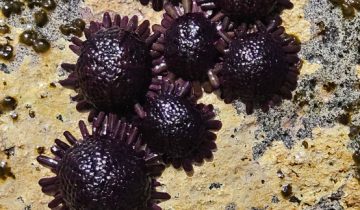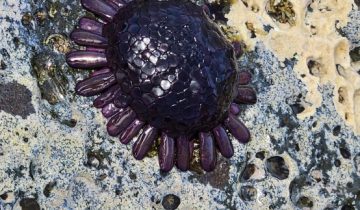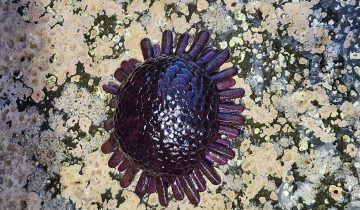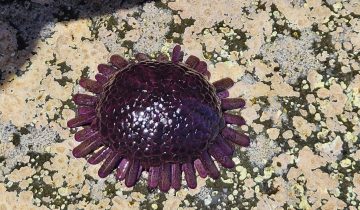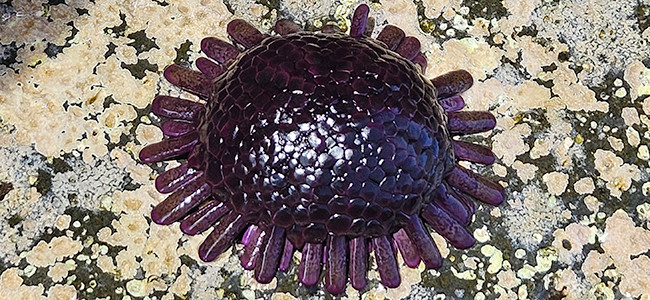Colobocentrotus atratus, commonly known as the helmet urchin or shingle urchin, is a species of sea urchin belonging to the family Echinometridae, within the order Echinoida. The genus name Colobocentrotus comes from the Greek ‘kolobos‘ (mutilated) and ‘kentron‘ (spine), referring to its modified spines, while the species epithet atratus means ‘dressed in black’, a reference to its dark coloration. This species is mainly found in the western Indo-Pacific, with particularly abundant populations along the rocky shores of Hawaii. Its natural habitat includes intertidal zones exposed to heavy surf, where it clings tightly to rocks.
The helmet urchin has a unique morphology that distinguishes it from other sea urchins. Its body is dome-shaped, resembling a limpet, and can reach up to 10 cm in diameter, although it is usually smaller. The upper surface is covered by a mosaic of polygonal plates formed from flattened and fused spines, giving it the appearance of a marine ‘shingle’ or shield. These plates are surrounded by a band of larger, flattened spines, while the underside features a second band of smaller spines and numerous tube feet. Its coloration is predominantly dark brown or deep burgundy. It can be easily distinguished from other species in the genus Echinometra by its flattened shape and smooth, compact dermal structure—features that allow it to thrive in highly wave-exposed environments.
Colobocentrotus atratus is an algivorous urchin, feeding mainly on calcareous algae such as coralline algae and algal biofilm, which it scrapes off the rock using its jaw apparatus, known as Aristotle’s lantern. It may also occasionally feed on small invertebrates like snails (Littorina) or smaller urchins. As a primary consumer, it plays an important ecological role in coastal rocky zones by helping to control algal overgrowth.
The reproductive biology of Colobocentrotus atratus is still not well understood. However, like most echinoids, it is presumed to reproduce via external fertilization. During the breeding season, individuals release eggs and sperm into the marine environment, where fertilization occurs planktonically. The resulting larvae (pluteus) swim freely in the water column before settling on the substrate and metamorphosing into juveniles. No active sexual selection or territorial behavior has been documented.
One of the most remarkable traits of the helmet urchin is its extraordinary adaptation to high-energy environments. Thanks to its hydrodynamic shape, modified spines, and especially the strength of its adhesion via tube feet, it can withstand currents up to three times stronger than those tolerated by other urchins such as Echinometra. This allows it to colonize areas that would be uninhabitable for other echinoderms. Additionally, its surface exhibits striking geometric regularity, with hexagonal patterns that make it a visual example of natural geometry. This species poses no risk to humans and has no known obligate symbiotic relationships, although it is often found in dense aggregations, benefiting from proximity to conspecifics to resist wave impact.
Photos:
